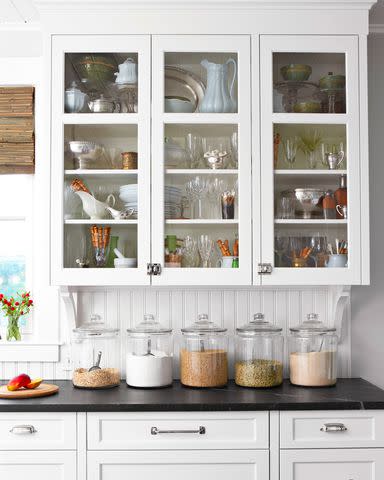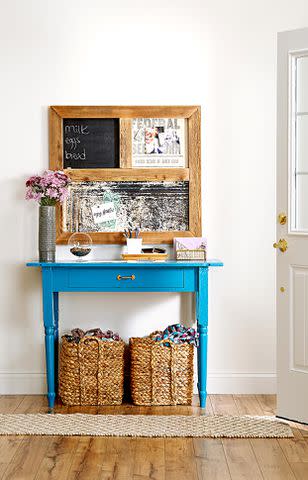7 Worst Home Organizing Mistakes and How To Fix Them

Look for these common storage mistakes and learn how to fix them with these tips on decluttering and making the most of your space.
It starts out innocently—a pile of papers on your console, a junk drawer collecting odds and ends, or a basket of clothes you've outgrown. Without a few organization strategies in mind, even the easiest storage solutions can quickly become cluttered. Worse, a messy space can add stress to your daily life. Here are some of the most common mistakes when it comes to organizing your home, plus the simple fixes you can take to streamline your space.

1. Setting Unrealistic Expectations
Why do show houses look so perfect? Because no one lives in them. While the perfectly styled images in a magazine and empty display homes can be sources of design inspiration, storage solutions should be customized. Find organization techniques that work for your home size, family lifestyle, and belongings. Once you've determined a strategy that works best, stick to a weekly cleaning checklist to make sure items are put back in place on a regular basis.

2. Holding on to Unused Items
Items that are outdated or damaged are obvious picks for discarding, but what about things that are in fine condition but you don't often use? Before organizing an area, take everything out and ask if it's something you really need. For clothes, consider the fit and whether you've worn them in the past year. Be realistic about what you might actually use in the future before returning items to their landing place. For example, if you've collected specialty small appliances over the years (waffle makers, egg cookers, juicers, and more) but rarely use with them, pare down to just the items used multiple times in a year.
:How to Sell, Donate, and Recycle the Clutter You Don't Need

3. Utilizing One Type of Storage
Your instinct might be to shove everything behind closed doors for a more streamlined look. But not being able to see certain items can lead to a heap of discarded (and forgotten) items. Opt for a mix of open and closed storage throughout your home to improve accessibility to your most-used items and conceal bulky, stock, or unattractive items. Open shelves in the kitchen make it easy to grab coffee mugs (we love this Better Homes & Gardens Abbott Stoneware Mug, $4, Walmart) each morning, while base cabinetry and drawers are better suited for tucking away cleaning supplies, formal place settings, and pots and pans.

4. Putting Papers in a Pile
Heaping papers into a stack is a temporary solution that can quickly result in missed payments or lost correspondence. Instead, create a command center that lets you easily sort mail into categories upon arrival. Consider digitizing receipts and documents instead of holding on to physical copies. And make sure to shred any paper items with personal information before discarding.
:22 Effective Ways to Organize Important Papers, Bills, Receipts, and More

5. Designating Decluttering to a Single Day
With so much going on each day, it's easy to let organizing fall to the bottom of your to-do list. But decluttering your home, or even a single drawer, is much easier (and less intimidating) when performed regularly, versus waiting for a single weekend each year. As you accumulate items, consider where you'll store each one as well as whether you have a similar item you can donate, making room for something else. By actively organizing throughout the year, you'll prevent a pileup of unwanted or duplicate items that require a day dedicated to decluttering.

6. Neglecting to Measure
When organizing your home, you'll need a few storage helpers to get cabinets, drawers, and closets in order. But before purchasing a shoe rack, behind-the-door organizer, or shelf riser, it's crucial to gather detailed measurements of the area you hope to organize. Additionally, consider the size of the items you're storing. Sure, your Dutch oven might fit the measurements of your kitchen cabinet, but with the addition of a 6-inch-tall riser, will there still be enough room to easily slide it out when needed? The same goes for closet storage. For over-the-door storage, consider the doorknob placement and depth of the unit. Will you still be able to close the door without bumping into clothing? Can a stand-alone unit fit through the framing of the closet? Take measurements twice before purchasing storage items to avoid creating additional problems.

7. Storing Donations Out of Sight
We all have that basket (ours is this Better Homes & Gardens Closed Weave Polyester White Decorative Storage Basket, $40, Walmart) or bin somewhere in our home that collects all the donation hopefuls. And while it might seem intuitive to hide these items in a basement or closet once you've finished decluttering, tucking away unwanted housewares can lead to a mountain of clutter. Instead, keep a container in plain view. As soon as it's full, make a trip to your local thrift store, resale clothing shop, or appropriate shelter accepting donations.